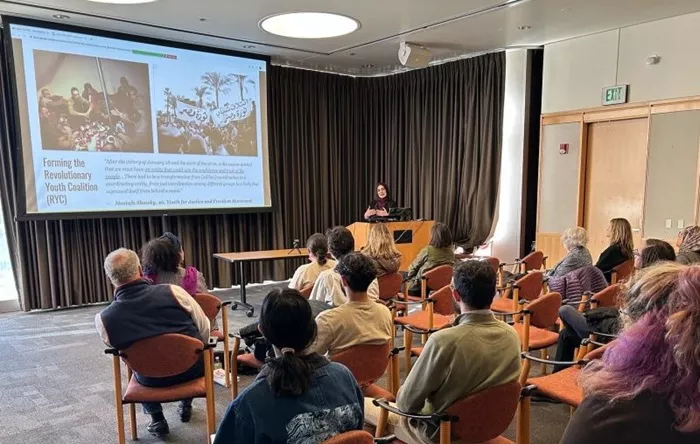Marcus Hall’s Studio 1 at San Francisco State University (SFSU) typically accommodates around 20 guests for lectures. However, on Wednesday, April 16, 2025, the studio overflowed with more than 35 attendees eager to hear Egyptian author Rusha Latif discuss her latest book, Tahrir’s Youth: Leaders of a Leaderless Revolution. The event, held in collaboration with Professor Dina Ibrahim from the Broadcast Electronic Communications Arts department, provided an insightful conversation on revolution, liberation, and political praxis.
Latif, whose book delves into the Egyptian revolution of 2011, shared her perspectives on how student activism and organization played a pivotal role in the movement. In her book, she chronicles the narratives of ten activists, tracing their stories from the beginnings of the revolution to its aftermath. Her analysis underscores the connection between the Egyptian uprising and global student movements, including the recent pro-Palestinian protests in the United States, particularly the campus encampments seen at SFSU in Spring 2024.
Latif explained the critical role that youth movements played on January 25, 2011, during the Egyptian revolution. “What the young people did on January 25 was that they managed to get all these people to come to the square, occupy it, and set up tents. We hadn’t seen that model before,” Latif remarked. She emphasized that this innovative method of protest was central to the revolution’s success, marking it as the first major 21st-century uprising with such “theatrics” and widespread involvement.
The protests on that fateful day were fueled by a desire to challenge the oppressive regime of Hosni Mubarak, who had been in power for over three decades. The protestors specifically called attention to police brutality, including the 2010 torture and killing of Khaled Said by Egyptian police. Mubarak ultimately resigned in February 2011, following a series of violent clashes that left over 6,500 injured and 840 dead.
Latif also pointed out that the roots of the Egyptian revolution extended beyond January 25. She linked the radicalization of many young activists to the 2000 Palestinian intifada, citing the tragic killing of Muhammad al-Durrah, a young Palestinian boy shot by Israeli forces while in his father’s arms. This event, according to Latif, politicized an entire generation of activists. “They were politicized and radicalized for the first time,” she noted, explaining how these young Egyptians later organized protests on their university campuses, inspired by a deep sense of solidarity with Palestine.
The conversation shifted to the broader implications of student activism in revolution and liberation movements. Latif’s book, Tahrir’s Youth, not only highlights the personal stories of activists but also traces how their commitment to justice spanned multiple causes. Latif argued that the struggles for liberation—whether in Egypt, Palestine, or other regions—are interconnected. “These struggles are so interconnected,” she said, “and that’s why I can title my book Tahrir’s Youth—because it speaks to more than just one revolution.”
Among the students who attended the event was Max Flynt, a member of SFSU’s General Union of Palestine Students. “I wanted to get an in-depth analysis from the author herself and hear from Professor Omar Zahzah, one of our esteemed professors here at SF State,” Flynt said, reflecting on the importance of the conversation.
Professor Omar Zahzah, an assistant professor of Arab and Muslim ethnicities and diaspora studies, moderated the Q&A session following Latif’s presentation. In an interview prior to the event, Zahzah emphasized the importance of Latif’s work in highlighting the strong connections between the Egyptian revolution and Palestinian solidarity movements. “When you look at it in that perspective, you see how Palestine is such a fundamental cause in relation to broader anti-oppressive struggles,” Zahzah explained. “Where you’re fighting oppression, Palestine is always relevant.”
Throughout the discussion, Latif stressed the significance of student activism in Egypt’s political landscape, particularly under the authoritarian rule of Mubarak. She noted that the regime’s efforts to eradicate political spaces on campuses spurred young activists to take to the streets. “It was that student activism, that collective action, that created the pressure necessary to bring about change,” Latif asserted.
Latif’s reflections on student movements resonated beyond the Egyptian context, especially in light of recent developments in the United States. She pointed to the ongoing struggles faced by international students, noting that over 1,000 students had their visas revoked this year, many due to their involvement in pro-Palestinian protests. “We still feel a connection to our countries of origin, but we have to recognize that our roles might be different and how to respect boundaries to engage with those movements,” she said.
The event, which was live-streamed to a broader audience, concluded with a deep sense of connection among the attendees, underscoring the lasting impact of student activism in global struggles for liberation.

